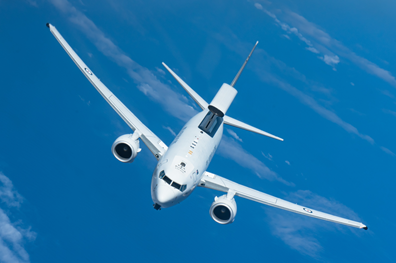
FARNBOROUGH—The U.S. Air Force is ruling out taking the British route of acquiring used Boeing 737 business jets to quickly convert to its new E-7A Wedgetail standard and requiring new build aircraft, though the company says it could accelerate its military line to speed up the program if there is enough demand.
Andrew Hunter, the Air Force’s assistant secretary for acquisition, says for the specific aircraft the Air Force needs to become the airborne early warning and control jet, there is a unique combination that would need to be new build.
“There’s not a lot of used aircraft out there we can just pick up and say, ‘Hey, we can use that,’” Hunter told reporters at the Royal International Air Tattoo in Fairford, England. “It’s going to be a new-build aircraft, and we are talking to others who are purchasing that same aircraft to try and make our process move as fast as possible. There’s opportunities in place to get after this very quickly.”
Buying new aircraft and finding a spot in Boeing’s production order is the driving force behind the service’s timeline. The Air Force expects to fund the first two prototypes in fiscal 2023 and 2024, with a production decision in 2025 and delivery in 2027. The service wants this “rapid” prototyping effort to replace its old 707-based E-3 Sentry fleet that has seen exceedingly low mission capable rates, with a potential buy of 22 aircraft. Initial operational capability (IOC) is targeted for 2030. Boeing recently said it would initially start bending metal on a prototype in 2025.
The UK’s Royal Air Force started its buy of three E-7s on the used market, acquiring two 737-700 Boeing Business Jets which it is converting to the Wedgetail standard at an STS Aviation facility in Birmingham. The third, a new-build aircraft, arrived from Seattle earlier this month.
Boeing’s military 737 production line in Renton, Washington, earlier this year slowed to producing 12 aircraft per year, down from 14, as it continues to shop the sub-hunting P-8 Poseidon to international buyers. Tim Flood, Boeing’s international sales director, told reporters at the Farnborough International Airshow that the company could accelerate this line again based on customer demand. A U.S. Air Force order of 22 E-7s would be a sizable demand for the line. The company had ran the line at a pace of 18 aircraft per year at the height of P-8 production.
In the meantime, Hunter says the Air Force has work to do on software and other technology development for the E-7 to ensure it is integrated into the Air Force fleet. Northrop Grumman also needs to produce the large Multi-Role Electronically Scanned Array radar for the aircraft. The company had about a 10-year hiatus from making the radar before the UK’s order, and it has been modernized to get around “significant” obsolescence issues and update it in other ways such as miniaturizing components, says Air Commodore Alex Hicks, the RAF’s assistant chief of staff for intelligence, surveillance and reconnaissance (ISR).
“I think we’re time up pretty well that when they have a green aircraft and they are ready to start missionizing it, we’ll be ready to load all of that onto the aircraft,” Hunter says.
The schedule will be used to reduce risk and work with allies that are also using the aircraft to accelerate test and prepare for a FAA certification process.
“I don’t know that, ultimately, there’s a huge opportunity to dramatically accelerate, like, IOC, but we’re very focused on achieving that IOC,” Hunter says.
